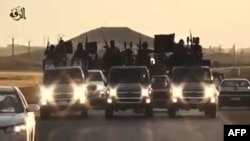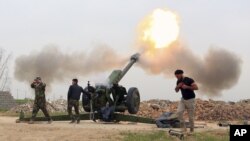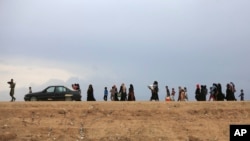Islamic State may have lost territory in Syria and Iraq, but the terror group has increased the tempo of its ground operations in both countries in the past three months, pulling off the highest quarterly attack total since it overran the Iraqi city of Mosul in June 2014, according to a new battlefield analysis.
While the IS attacks have not seen the militants wrest back any substantial chunks of its shrinking self-proclaimed caliphate, the ferocity and pace of the group’s attacks are testimony to its continued durability and resourcefulness, highlighting the challenge its various foes face in defeating it.
“Following territorial losses, we are seeing a steady upward trend in the tempo of Islamic State operations worldwide, but particularly in Syria and Iraq,” warns Matthew Henman, head of Jane’s Terrorism & Insurgency Center, part of the U.S.-based analysis firm IHS.
Attacks on rise
“Attack and fatality numbers have jumped. The group is resorting more and more to mass-casualty violence as it comes under heavy pressure from multiple angles,” he added.
There were 891 IS attacks during the first quarter of 2016 in Iraq and Syria, more than in any three-month period since mid-2014, when the terror group made sweeping advances across both countries. The 2016 attacks have killed 2,150 people, a 44 percent rise over the previous quarter and the highest three-month death toll in almost a year, according to the IHS analysis.
U.S. officials estimate IS has lost about 40 percent of the territory it once held in Iraq and nearly 25 percent in Syria. The serious loss of territory began with the fall of Tikrit last May to Shi’ite Iraqi militias. In December, Iraqi government forces took back the western Iraqi city of Ramadi.
Russian-backed Syrian regime forces recaptured the town of Palmyra from the militants last March.
IS recalibrating
The accumulating battlefield losses for the terror army were greeted as a serious setback for an organization that once boasted it would “remain and expand.” Last month IHS concluded in another report the tide had turned decisively against the extremist organization in Syria. IS has failed to pull-off a successful large-scale ground offensive in Syria since May 2015 when it captured Palmyra after a lightning offensive across the desert, but it has learned to recalibrate its battlefield tactics to better evade airstrikes by using highly mobile small-force attacks, say analysts.
In Iraq, IS has managed to slow advances on Mosul using snipers, improvised explosive devices, suicide bombers and small-force attacks. When they lose villages, attacking forces have to spend considerable amounts of time sweeping for mines and clearing out booby-trap bombs.
And since the successful Russian-backed assault by forces loyal to Syrian President Bashar al-Assad on Palmyra, the grabbing back of territory from IS has been painfully slow, with the various alliances against it grappling with their own internal problems and disunity or distracted by targeting other foes.
Iraqi government forces have been bogged down for weeks on the outskirts of the village of Al-Nasr, 56 kilometers south of Mosul. IS has battered back assaults on the village, which reportedly had been designated for capture more than a month ago. Iraqi Kurdish fighters have publicly complained at the slow pace of movement by Iraqi government forces, which are in the lead.
Key ingredient missing
According to analysts, one key ingredient in fighting IS is missing as local tribes are not turning en masse against Islamic militants in either Syria or Iraq. U.S. and anti-IS coalition allies have been seeking to replicate the Sunni Awakening of 2006, when a Washington-coaxed tribal uprising was a key element in assisting U.S. troops to drive al-Qaida jihadists from Iraq’s westernmost Anbar province.
An expected flood of defecting tribesmen has not materialized, Charlie Winter, an analyst at Georgia State University’s Transcultural Conflict and Violence Initiative, told VOA earlier this year. He said much of the reason for the absence of a tribal uprising lies with IS efforts to keep the tribes in line.
“IS has been working on tribal relations for a very long time now. The networking infrastructure IS has established, principally in the form of the Diwan al-'Asha'ir (Diwan for Tribal Outreach), enables it to anticipate and carefully respond to the complex tribal dynamics of Iraq and Syria.”
It has also used brute force to discipline the tribes with massacres and collective punishment for any dissent or defiance. With the high tempo of IS operations, locals who may have been tempted to break with the terror group are deterred from doing so, fearing the consequences.
The highly complicated and sectarian politics unleashed by the micro-conflicts in the Syrian war and Iraq battles also pull against a tribal uprising.
And the sectarian disputes in Baghdad, which teetered on the edge of political chaos this past weekend when protesters led by Shi’ite cleric Moqtada al-Sadr crowded the streets in front of the country’s parliament, will likely further disrupt the focus on Mosul. U.S. officials fear the loss of political momentum and unity in Baghdad will lead to a loss of military momentum against the Islamic militants.









